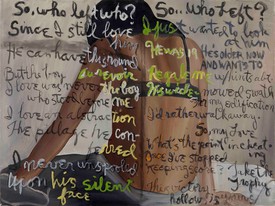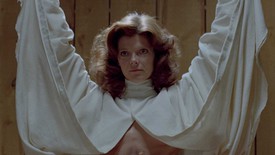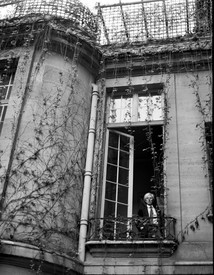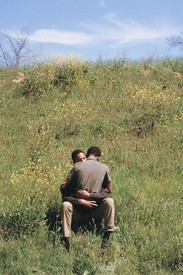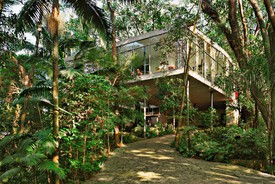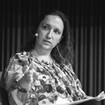
Alison McDonald has been the director of publications at Gagosien since 2002. During her tenure she has worked closely with Larry Gagosien to shape every aspect of the gallery’s extensive publishing program and has personally overseen more than six hundred publications dedicated to the gallery’s artists. In 2020, McDonald was included in the Observer’s Arts Power 50.
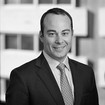
Luke Nikas is a partner at the law firm of Quinn Emanuel Urquhart & Sullivan, LLP. He represents prominent artists, collectors, foundations, and galleries. He was recently named to Lawdragon’s list of the 500 Leading Lawyers in America, Benchmark Litigation’s “Under 40 Hot List,” the New York Law Journal’s list of Rising Stars, the Best Lawyers in America, and the Super Lawyers list by New York Super Lawyers. He was called one of the most “highly influential” art lawyers in the world after he led the defense in a forgery case dubbed by Artnews “The Art Trial of the Century.”
Alison McDonald Let’s start with your background. How did you come to focus on art law?
Luke Nikas My training is in litigation. I started my career representing large banks and other corporations in complex financial disputes. These were cases with documents totaling in the hundreds of thousands or more. I had to distill really complex situations into stories that were both compelling and understandable to judges and juries.
In 2010, the Andy Warhol Foundation for the Visual Arts came to my firm with an antitrust case, which we won. I noticed then that the art world had many experienced transactional lawyers doing good work on consignments, tax structuring, estate and foundation planning, and so on, but it was clear to me that the art world needed trained litigators who could approach disputes with the necessary background and skills.
AMCD And what are you focusing on now?
LN My current art practice centers on any claim of wrongdoing related to art: copyright infringement, trademark disputes, Nazi-looted art, negligence, fraud, racketeering, antitrust, theft, forgery, misrepresentation, contract disputes related to deals, insurance coverage.
AMCD Litigation seems to be far more prevalent now for art-world transactions than ever before, which I suspect has to do with the rising value of artworks. There seems to be a lot of case law being written now.
LN That’s exactly right. Most people consider what is at stake financially before incurring the considerable costs and risks of litigation. There is an explosion of art-related disputes because the increasing value of art makes the cases worth pursuing or defending against.
AMCD Does the amount of litigation now taking place affect the work of scholars and other art experts? Are people still able to say “This work is valuable,” or “This work is actually not by the artist”?
LN This is one of the biggest concerns of most experts, foundations, and catalogue raisonné authors. Some experts will say, “I’m not going to say ‘authentic’ or ‘inauthentic,’ I’m going to say a work is ‘right’ or it’s ‘good.’” There is some sense that this language protects them better than saying a work is fake or real. And there’s fear about saying more. Other experts will say nothing at all. My biggest message about authentication is that it’s not as scary as people think it is. Courts have regularly protected experts who acted in good faith. Courts have consistently ruled that the art market, not a court of law, is the right place for resolving authenticity disputes, because courts aren’t art experts. They want to let the market decide the issue of authenticity whenever possible. Courts have also enforced contracts against people who have sued experts over adverse opinions on authenticity. For example, in the Thompson versus Warhol Foundation case [Addison Thompson v. The Andy Warhol Foundation for the Visual Arts Inc. et al., 2013], where I defended the Warhol Foundation, the court dismissed a case by an individual who sued the Foundation and its Authentication Board. It said that the art market is the place for resolving disputes about authenticity, and the contract that the Art Authentication Board required the owner to sign protected the Foundation and the Authentication Board from the suit.
There is also very good case law in the First Amendment area, where, for example, courts have ruled that if you’re giving an opinion about a work of art in good faith, then you’re protected by the First Amendment. Opinions are subjective; they’re not objective statements of fact.
So authentication can happen; it needs to happen; it’s important for it to happen. The real question is how do you protect against lawsuits? You can never stop someone from filing a case, so what do you do to set yourself up correctly? There are cases that give us guidance, and if you rely on those cases, if you structure yourself right, and if you’re consistent in what you do, you’ll be okay.
AMCD Does your expertise prescribe any best practices for foundations or estates around authentication, or for catalogues raisonnés?
LN The first thing to think about is how to insulate your assets. Authentication, in one form or another, is the riskiest activity that most foundations will undertake if it isn’t done properly. In most circumstances, I recommend setting up a separate corporate entity that will house the catalogue raisonné or authentication board. So if someone sues the authentication board or the catalogue raisonné authors, saying, “You’ve given an opinion that’s destroyed the value of my work,” that person may have a suit against the authentication entity, but your business or foundation will be legally walled off from liability. That works as long as you’ve truly treated the authentication company as a distinct company. So number one, set up a separate company and treat it as a separate company. And then be careful not to create conflicts or other governance problems when nominating board members and staffing the executive roles.
The second step is to put the right contracts in place. As I mentioned earlier, the Warhol Foundation was protected in the Addison Thompson case because the Authentication Board had a contract that said, in sum: “You, owner, understand and agree that the opinion you will receive in connection with this authentication review is subjective, not true or false. It’s subject to change based on information we may obtain later. It’s an opinion that you will not sue us on; whether it’s good or bad, you will not sue us. You agree that if you do sue us, or if someone else sues us, you’ll indemnify us for any damages we incur.”
Think about that—you will have to pay our legal fees for defending against your lawsuit. The case law says you can do this, if you do it right, and experts should require this protection. The contract must also identify the right state for the law that will apply. Some states say “X” is the rule, and some say “not X” is the rule. Some states have never addressed the key issues that might come up in an art dispute. Make the rules as predictable and favorable as possible before you end up in litigation. Also, do you want to be in open court, or do you want to be in arbitration? Choose—there are pros and cons to each. But have a contract in place that protects you and gives you as much certainty as possible.
Number three: carefully plan how you interact with the outside world. Are you an authentication service? Are you a catalogue raisonné? Figure out your mission and stick to it, because the precautions and planning are different depending on what you’re seeking to accomplish. Let’s cover a few examples in the context of a catalogue raisonné.
Don’t tell people beforehand if a work is going to be included in or excluded from the catalogue raisonné. Why? Because someone can, and will, take your email, letter, or opinion and tell prospective buyers, “The catalogue raisonné said this is an authentic work.” What if you change your mind before publication? What if you’re wrong? In the buyer’s eyes, you’ve given an authentication opinion that facilitated commerce, so you’ve opened yourself up to an unnecessary commercial dispute. Or, if you give a negative opinion, you’ve destroyed the value of a work and created a risk of litigation that could have been better managed had you simply published the catalogue.
Don’t verify that an image that someone sends you depicts a work in your catalogue raisonné—or, if you’re an authentication board, a work you’ve reviewed. Why? Although you might accurately be able to say, “We have a work in our catalogue raisonné that matches the dimensions, colors, and so on, of the work in this image,” you don’t know whether the image that’s attached to the email is in fact the work you looked at. You don’t want to quasi-authenticate the work in an image when it’s not actually the real work. Art forgers also forge documents.
For the catalogue raisonné, you also want to consider how to publish it. I always approach cases and problems by thinking about the touchpoints with people and companies that are causing my client’s problem, or could cause my client harm. Where do they intersect with my clients—physically, financially, contractually, in the cloud, on the Web—and how do I manage, leverage, and defend against harm at those intersections? Let’s consider an online catalogue raisonné. The first touchpoint is the access gate for people viewing the website around the world. Do you have the appropriate waivers in place when people access the catalogue raisonné? Choice of law and venue for disputes? Other terms that will protect you? Think about any time you’ve bought something online: for almost every single type of online transaction you can think about, you have contracts that pop up before you can move forward.
My biggest message about authentication is that it’s not as scary as people think it is. Courts have regularly protected experts who acted in good faith. Courts have consistently ruled that the art market, not a court of law, is the right place for resolving authenticity disputes, because courts aren’t art experts.
Luke Nikas
AMCD Does your law degree help you read and understand those?
LN No, who really knows what’s in there? [Laughter] The question is, are these types of clickwraps enforceable? If done the right way, yes, they are. So what’s your opportunity at that touchpoint? You can choose the governing law. Are they waiving claims? Arbitration or not? This is an access point that you control, so you should have terms that protect you. If you’re not publishing online but have decided instead to print a book, you can put terms in the back of the book that offer protection. Or you can shrink-wrap the terms right on the book.
The bottom line is to think about the touchpoints. They’re all over—take advantage where you can. And then think about how you interact with people. You must be consistent, whether it’s a powerful auction house or a new player in the space.
AMCD You just advised that the editor of a catalogue raisonné not say anything beforehand about whether or not a work will be included in the publication. But obviously, in the case of a printed book, a work is either included or not in the end, right?
LN Yes, and that’s fine. My view is that as long as you’ve protected yourself in these and other ways, your book is a work of scholarship; it’s an opinion. It’s almost certainly going to be protected. Scholars are afforded a wide latitude to say what their opinions are.
But it’s important to remember that publishing a book is one type of activity and acting as an authentication service to the art market is another. You can do one or you can do both, but figure out what you’re going to do. Because once you start allowing exceptions to your policies, or creating policies without your mission in mind, you risk a chaos and inconsistency that will be problematic. You need to be consistent in how you implement your operations. You need to be consistent in the way you deal with people. You need to be consistent in every way, all the way down to the way you write emails based on the type of information people are seeking or you are providing.
AMCD What specifically would you recommend for experts and scholars to put in place in order to protect themselves if they’re authenticating work or editing a catalogue raisonné? They’re not usually the ones with teams of lawyers looking out for their best interests.
LN First, if you can get insurance, get it. Some insurance carriers won’t extend it, some will. Look at your homeowner’s policy to see whether it covers defamation. You should look at the policy carefully.
Second, know your contact and understand how they’re going to use your opinion. Make sure you trust the situation and pay attention to the circumstances.
Third, if you write your opinion, you need to put in some basic disclaimers, like, “This is my opinion, not to be relied upon by any third party. I give it to you and only you. You agree that you won’t sue me based on what’s in this opinion. You agree that you’ll indemnify me for any lawsuits that are brought against me, including defense costs, in connection with this opinion.” These are important concepts to include. If you’re giving your opinion orally, it’s best to have a contract in place, even if it’s an email that incorporates the above concepts and says something like, “I’ll tell you my views of this, but understand, this is an opinion. It’s subjective. It’s based on the information you’ve given me, which includes the following, and I could change my mind based on more or different information of which I’m not now aware. You agree not to sue me based on this.”
Those are the key things that I would do as an expert. And my general advice would be, Don’t do this, ever, unless you’ve gone to a lawyer. I appreciate that not everyone has the means to do that, but it’s possible to find someone who will give you far-reaching advice that you can use repeatedly in these scenarios. That advice will cost a small fraction of the legal fees if you end up in litigation.
AMCD And if I were an artist thinking about legacy planning, what are some of the key things I should be thinking about? What can I put in place now that would be most helpful to protect scholars and experts in the future?
LN To the extent possible, have a photo record of what you’ve created—ideally, back and front. Have documents related to where each work went, to support the provenance. Do this in an orderly way—if you can, attach numbers to your works, in the same way that a catalogue raisonné would assign a number. Leave information that can help guide scholars through your works—the history, the materials you used, the people connected to your studio who had access to you and your work, the authentication approach.
You need to be consistent in how you implement your operations. You need to be consistent in the way you deal with people. You need to be consistent in every way, all the way down to the way you write emails based on the type of information people are seeking or you are providing.
Luke Nikas
AMCD Is there a benefit to starting a catalogue raisonné while the artist is living?
LN That’s really a question about whether we can understand an artist’s legacy and present a body of work more accurately, or from a better perspective, when the artist is no longer alive. In my view, it depends on the artist. Regardless, doing the preparation, keeping the archives, and keeping information orderly during the artist’s lifetime will make the raisonné project much easier to manage later.
It’s also critical to think about intellectual property [IP] issues when the artist is alive. A lot of foundations aren’t just giving grants, producing catalogues raisonnés, and authenticating, they’re also managing the artist’s brand, through books, exhibitions, and licensing activities. To do this safely and without interruption, you need to properly manage and determine the intellectual-property rights, such as trademarks and copyrights. But artists don’t always protect themselves: they transfer copyrights to a patron without clear terms, they license the use of certain images without reasonable restrictions, they bequeath their IP rights evenly to a divided family, they don’t copyright certain works during required periods, or they just simply fail to protect their IP rights. This creates problems and unpredictability when developing a plan to use the IP.
Artists should have someone look at their full IP portfolio and ask themselves, “How do we want to use the name? How do we want to use the signature? What images have I created?” And then, in certain instances, file for trademarks, file for copyrights, and put in place the right IP agreements.
AMCD And without clear ownership of the IP in place, it becomes very difficult to embark on scholarly projects such as catalogues raisonnés, right?
LN It certainly can be. Although there are some very strong fair-use copyright cases in this area, all it takes is an aggressive person or entity on the other side to create a costly dispute. And every single artist’s estate, foundation, and living artist needs to think about several questions: “How are we going to use this IP? What are the potential ways we could use this IP? Do we want to create products? Do we not want to create products? Do we want a website? Where do we want images of the artist’s signature, name, and art to appear? Where don’t we want them to appear?” If you don’t protect yourself and the IP in certain ways, you could lose the rights to assert.
This is all to say that, in addition to cataloguing works for a catalogue raisonné or for authentication purposes, as an artist you need to think about your legacy. What financial resources will your foundation have or generate to carry out your mission? How will licensing factor into the foundation’s plan? How will the foundation manage your legacy and protect your market, if it will at all? So protect your IP, and put in place the agreements you need in order to protect your IP, because that, for many, is an important part of legacy management.
AMCD Tell us about the arbitration court you’ve helped to establish in The Hague and how that came about.
LN There is currently a major disconnect between how the courts understand the art world, how juries understand the art world, and what’s really going on in the art world. I’ve conducted multiple focus groups and mock trials for my art cases, so I have a deep understanding of the psychological factors that drive decisions in these cases. A few years ago, I was at a New York City Bar Association meeting and Bill Charron from Pryor Cashman, who is on the advisory board of Authentication in Art [a nonprofit founded in 2012 to develop and promote best practices related to authentication], announced that Authentication in Art had raised the idea of establishing an international art court. He invited anyone interested to speak with him about it. I’d been thinking a lot about this disconnect and how to solve it. I spoke to Bill and soon after joined a small working group with him to start the process of creating the court. I did background-literature research and proposed a structure for an arbitration system specifically designed to resolve art disputes. And I read scientific journals and law-review articles that discussed the gap between the scientific knowledge that’s necessary to understand patent cases involving complex technology and the knowledge that most people on a jury will have of these issues. The articles proposed various ideas about how to bridge that gap, including specialized patent juries and other experts to oversee the case and discovery process.
After reviewing the literature, I concluded that we should have a court that has art experts on the panel—all lawyers, but with experience in some area of art law, broadly defined, so they can resolve legal issues with an inherent understanding of this industry. There will be a pool of qualified experts to draw from. The panel will retain the relevant experts. Those experts will be protected in various ways, so they can offer uninhibited opinions. There will also be a special master to oversee the discovery process, so when the expert issues his or her opinion, the special master can say, “You need to do this, you need to do that, you need to do more research.” The special master is a bridge between the panel and the experts, ensuring that the discovery and expert testimony is helpful and comprehensive. It’s a better system than what our pure adversarial model offers today. There will be a mediation service too.
Our working group then collaborated to draft the rules. We proposed them to Authentication in Art and an entity that already has a significant arbitration entity for sports disputes, seated in The Hague, as the basis for an art-arbitration court. And now it’s well underway: we’ve got the infrastructure in place, there are applications for being an arbitrator in this court, for being an expert . . .
AMCD What kind of lawsuits will they hear?
LN Any kind of art dispute.
AMCD International?
LN Yes, and domestic. That’s a virtue of arbitration.
AMCD What if you have a contract in place that says any dispute is to be settled by the laws of New York, would it ever go to that court? Can it go to this arbitration court if everyone agrees?
LN Yes.
AMCD And the benefit of arbitration court is that it’s much less expensive than going through with a lawsuit?
LN It should be less expensive, and there are very few appeals. You’ve got a panel of qualified experts who are giving testimony, and a panel of lawyers who have experience in this area, so you’re going to have a more sophisticated decision-making process than if you were in a court that doesn’t have the same knowledge of the art world and the art.
AMCD What do you expect some of the impacts will be?
LN There’s an art-specialized mediation group, so the possibility of litigation is a bit lower, and then if there is litigation, you’re not factoring in as great a risk of loss due to misunderstanding or court error. I think that will have a ripple-on effect, with people having more confidence in the outcomes—
AMCD It offers more security.
LN Yes. I would rather litigate before a panel of three people who know how the art world works and understand the law that applies. And experts have confidentiality and indemnification from the group itself, meaning they have protection and are therefore more willing to participate.
We were able to structure this so the arbitration is seated wherever the parties choose to have it seated. You can be in New York City, under New York law, or wherever you want to be, and have access to the same panel of lawyers, the same panel of experts, and the connoisseurship and the science. So it gives people flexibility, which is the point of arbitration. You want people to have flexibility charting their dispute-resolution course and confidence in the final decision.
AMCD So you’re an attorney focused on art litigation brokering for fewer art-focused lawsuits?
LN I’m a trial lawyer at Quinn Emanuel Urquhart & Sullivan, and we focus exclusively on litigation and trials all around the world. We prepare every case from day one as if it’s going to trial. But my goal is to accomplish the best result for my clients, whether that’s through an immediate settlement or a trial. Many disputes drag through the court system so long because one side is being unreasonable, not because the facts or law justify a drawn-out war. My hope is that the art mediation service will reduce the number, or length, of those disputes. Other disputes require a trial or extensive litigation to hold wrongdoers accountable, to get the right outcome, or to show the world that the client did nothing wrong. When that’s the case, the arbitration court will be an excellent venue.


